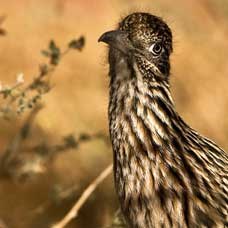
NPS Photo | |
|
Bald eagles and golden eagles soar in the winter, migrating songbirds dart through in spring and fall, and year-long residents like white-throated swifts and canyon wrens are just some of the more than 190 bird species you'll encounter at El Malpais National Monument. A variety of habitats--such as andstone cliffs, shortgrass prairies, scrubland, and rugged lava flows--offer a variety of birds to watch any time of year! Great birdwatching sites along Highway 117 include Sandstone Bluffs, La Ventana Natural Arch and Narrows Picnic Areas. Highway 53 on the west side of the monument offers access to the El Calderon area, Zuni-Acoma Trail, and County Road 42 . Summer monsoons create vernal, or seasonal, ponds along roadsides that attract visitors such as great blue herons. Always be aware of your surroundings while bird watching. 
NPS photo Dale Dombrowski Raptor and Bird MonitoringWhile bird watching, you can help the Natural Resource rangers track what birds come and go from El Malpais. Although most monitoring occurs on the east and northwestern sides of the monument, there are 114,000 for birds to live. | |

NPS photo Dale Dombrowski RaptorsEl Malpais offers both open scrubland and grasslands for raptors such as red-tailed hawks (Buteo jamaicensis), American kestrels (Falco sparverius), and the occasional peregrine falcon (Falco peregrinus) to soar and hunt over. More elusive, and nocturnal, great horned owls (Bubo virginianus) and western screech-owls (Otus kennicottii) perch in the more established forests and individual trees in and around the lava flows. 
Photo Dale Dombrowski Blink and You Might Miss ItMade famous from cartoons, the Greater Roadrunner (Geococcyx californianus) is not as common at El Malpais as other parts of the region. Sightings aren't exactly rare, but also not common since roadrunners prefer open areas to capture prey. Prey items include scorpions, rattlesnakes, spiders, and a number of other small animals. On occasion, these birds may team up to capture larger rattlesnakes. A full list of El Malpais birds is under construction and will be available for future download. | |
Last updated: May 6, 2025
